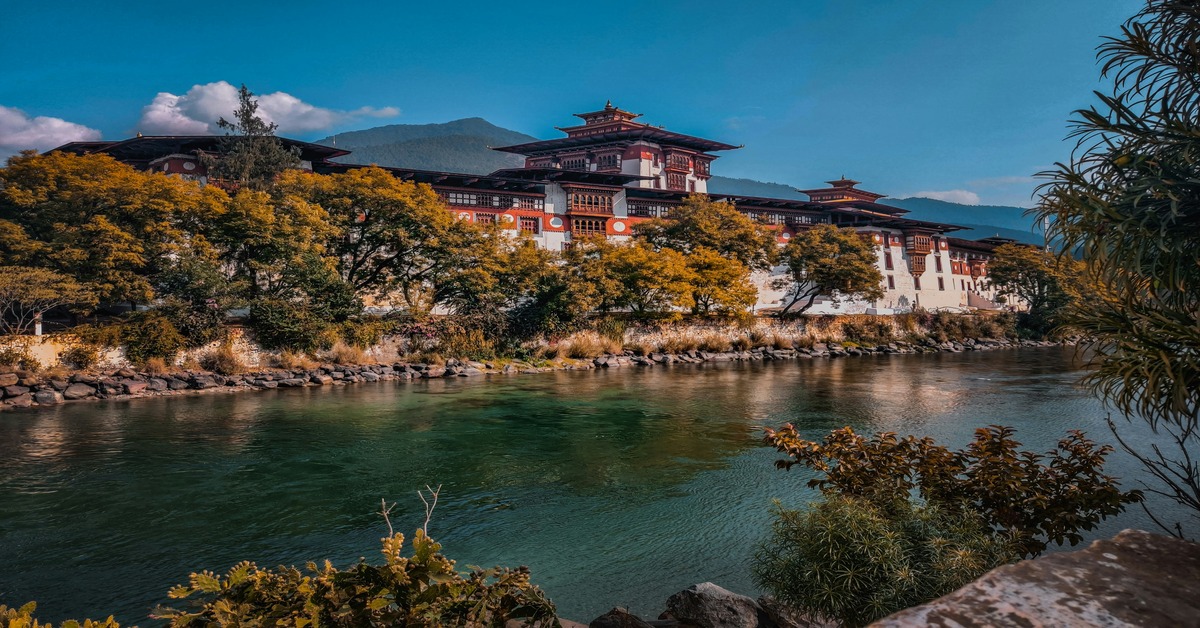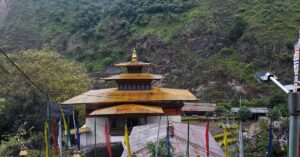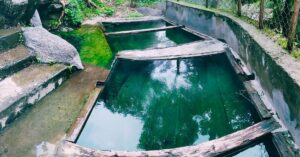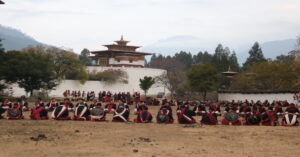Punakha Dzong, also known as Pungthang Dewa Chhenbi Phodrang, is one of the 16 dzongs built by the Zhabdrung Ngawang Namgyal in Bhutan as an “embodiment of Buddhist values”. The Punakha Dzong was built in 1637. It is the second oldest after Simtokha Dzong.
Pungthang Dewa Chhenbi Phodrang is also the second largest dzong in Bhutan, and houses the sacred relics of Bhutan, Rangjung Kharsapani, and the holy remains of Zhabdrung.
Punakha Dzong fortress is located at 1,200 m (3,900 ft) at the confluence of the Pho Chhu (Male) and Mo Chhu (Female) rivers in Punakha Dzongkhag. Punakha Fort is a tentative site on Bhutan’s Tentative List for UNESCO inclusion.
Pungthang Dechen Phodrang was the center of the capital of Bhutan until 1955, when it was moved to Tashichho Dzong in Thimphu. Now, it is the administrative center of Punakha District and the winter residence of the central monastic body.
How to Reach Punakha Dzong
Punakha is 72 km from Thimphu, the capital of Bhutan. From Paro International Airport, it is 130 km. Drive to the parking area and cross the Bazam Bridge to reach Pungthang Dewa Chhenbi Phodrang, the palace of great bliss.
Also Read: Wangdue Phodrang Dzong, the Fortress of Glorious Unification
Sacred Relics to See at Punakha Fortress
- Rangjung Kharsapani;
- Holy remains of Zhabdrung;
- Holy remains of Jampel Dorji, Zhabdrung’s son;
- Holy remains of Pema Lingpa;
- Gold statues of the Buddha, Guru Rinpoche, and Zhabdrung;
- Punakha Dromche and Tshechu festival;
- Dzong Chung.
Also Read: Guru Rinpoche in Bhutan: His Visits to Bhutan and Sacred Sites
History of Punakha Dzong
According to the history of Punakha Dzong, Guru Rinpoche prophesied that a person named Namgyal would arrive at a hill that looked like an elephant and build a dzong. While Zhabdrung was in Goen Tshephu Ney, Guru Rinpoche appeared and advised him to construct a fortress to propagate dharma.
As per the prophecy, Ngawang Namgyal reached Lobesa, visited Chimi Lhakhang, and spent a night there. Zhabdrung Ngawang Namgyal had a dream of Demchok Padma Vajra Yab-Yum, the red Yeshey Gonpo Chazhipa. He was asked to enter Punakha Valley, but there was no bridge. The villagers built a bamboo cane bridge so Zhabdrung could cross the river.
When the Zhabdrung reached Punakha Valley, he recognized the hill that resembled a sleeping elephant. He then chose the tip of the trunk of a sleeping elephant near the Dzong Chung as the prophesied site. Drubthop Naggi Rinchen built the Dzong Chung in the 13th century.
Zhabdrung then laid the foundation of the dzong on the 8th day of the 8th month of the Fire Ox Year in 1637 and appointed Zow Balep as the chief architect. Before the construction, Zhabdrung ordered Balep to sleep under Dzong Chung, built in 1326, and pray to a wish-fulfilling statue of Sakyamuni.
Zow Balep, in his dream, envisioned a “Palace of Guru Rinpoche.” Based on his dream, he conceived the plan for the dzong, started the construction in 1637, and completed it in 1638. During the consecration ceremony, the Dzong was named Pungthang Dechen Phodrang, “The Palace of Great Bliss on the Ground of the Heaped Jewel”.
In 1639, a shrine was constructed to commemorate the victory over the Tibetans and house the arms seized during the battle. The Zhabdrung also established a monastic school with 600 monks from the Cheri Monastery.
Also Read: History of Tashichho Dzong, a Fortress at the Site of Blue Stone Dzong
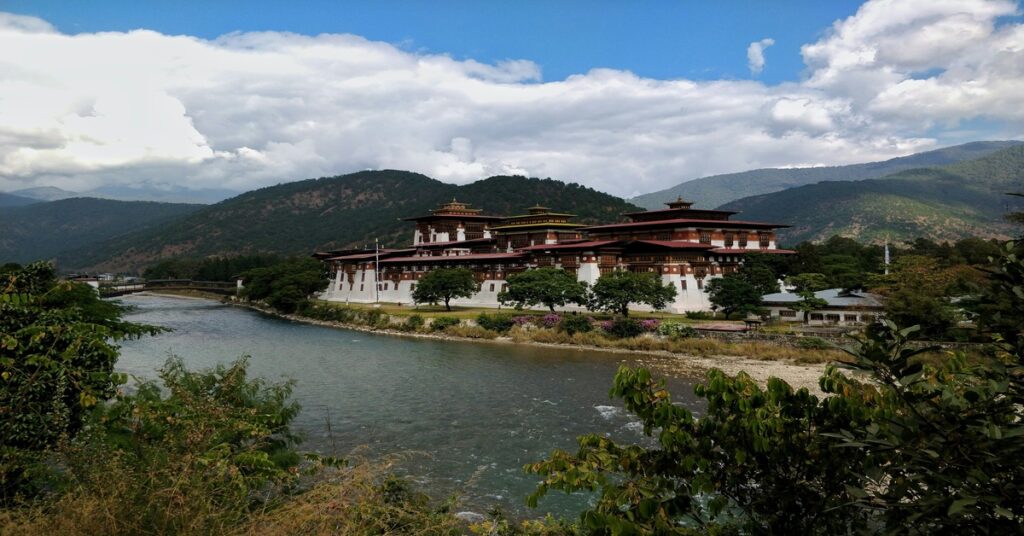
Why was Punakha Dzong built?
Punakha Dzong was built as an “embodiment of Buddhist values,” fulfilling a prophecy by Guru Rinpoche and also to serve as a major administrative and religious center, to symbolize national unity, house sacred Buddhist relics, and defend against invasions by Zhabdrung Rinpoche.
Significance of Punakha Dzong
Punakha Dzong is a significant cultural and historical landmark in Bhutan, constructed by Zhabdrung Ngawang Namgyal in 1637-38.
So, here’s the historical importance of Punakha Fort. The Dzong houses the most sacred and national treasure, Rangjung Kharsapani. It also has the preserved bodies of Zhabdrung, his son Jampel Dorji, and Pema Lingpa.
Gongsa Ugyen Wangchuck, the first Druk Gyalpo, was enthroned in Punakha Dzong. Since then, all our Kings and Je Khenpos who followed began their reigns by receiving the blessed five-colored scarf from the inner sanctum of the sacred Marchen Lhakhang.
A treaty of Punakha was signed here on January 8, 1910. Punakha Dzong was Bhutan’s first capital and the site of the first National Assembly held in 1953.
The fortress also hosted the notable royal wedding of the fourth king on 31st October 1988 in Dechog Lhakhang, and the fifth king and Queen on 13 October 2011.
Also Read: Zhemgang Dzong, the Symbol of Unification of Khengrig Namsum
Description of Punakha Dzong Complex
Walk through the new wooden cantilever bridge built over the Mo Chhu River in 2008. The old bridge of the 17th century was washed away by a flash flood in 1957. Once inside, climb the steep wooden stairs to enter the first courtyard of the dzong.
Punakha Dzong is a six-story structure with a central tower or utse. The architecture is intricate with towering exterior walls surrounding a complex of courtyards, temples, administrative offices, and monks’ accommodation. The spire at the top of the Utse was added in 1676 by Gyalsey Tenzin Rabgye. The materials used in building the Dzong consisted of rammed earth, stones, and timber for doors and windows.
The dzong was enlarged during the rule of the 13th Desi Sherab Wangchuk from 1744 to 1763. One unique feature he added is the Utse, which has a Chinese-style golden roof like the Utse of Tashichho Dzong. He also donated a large Thangka known as Thongdrel Chenma of Zhabdrung. This Thongdrel is displayed during the annual Punakha Tshechu. The 7th Dalai Lama has also donated the brass roof for the dzong.
In 1978, Queen Mother Ashi Kezang Choden Wangchuck built Demchok Khorlo Lhakhang in the Dukhang. This temple houses some of the most sacred statues sculpted by Jinzop Damcho.
Also Read: Description of Paro Rinpung Dzong, the Fortress on a Heap of Jewels
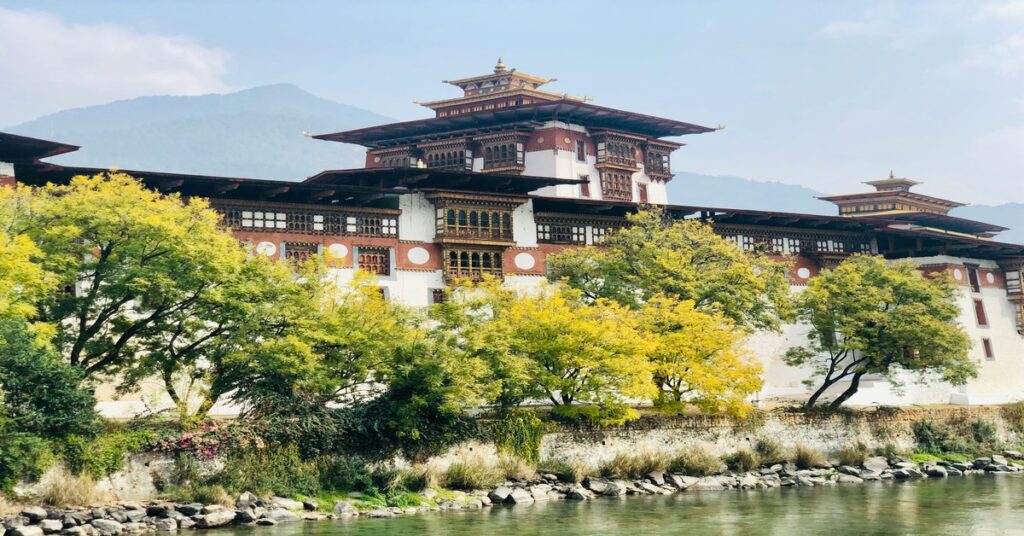
Pungthang Dechen Phodrang, the Palace of Great Bliss
Punakha Dzong has three Docheys or courtyards, instead of the usual two. The first courtyard is for administrative functions and houses a huge white Victory Chorten and a Bodhi tree. A mound of stones and a shrine dedicated to Tsochen, a queen of the Nagas, are located in the far-left corner.
The second courtyard houses the monastic center and the residential quarters of monks and is separated from the first by Utse. This courtyard has two historic halls, one used when Ugyen Wangchuck was presented with the Order of Knight Commander of the Indian Empire by John Claude White in 1905, and the other where he was enthroned as the first king of Bhutan in 1907.
The third courtyard is at the southernmost end of the dzong, where the remains of Ngawang Namgyal and Terton Pema Lingpa are preserved. This courtyard has the sacred Machey Lhakhang with the embalmed body of Zhabdrung. The Machen Lhakhang, rebuilt in 1995, is not open to all. Only the king and Je Khenpo, besides two guardian lamas, enter this Lhakhang.
The Kunrey, or ‘hundred-pillar’ assembly hall, is the only temple open to visitors. There is a mural depicting the life story of Buddha commissioned during the rule of the second Druk Desi. The hall also has huge gold statues of the Buddha, Guru Rinpoche, and Zhabdrung from the 18th century.
Also Read: Gasa Dzong, the Fortress that defended against Northern Invasions
National Treasures
The most treasured possession of Bhutan is the Rangjung Kharsapani, a sacred relic of Chenrezig inside a crystal glass in the Tse Lhakhang in the Utse. It is a self-manifested image of Avalokiteshvara from the vertebrae of Tsangpa Gyare. The holy relic was brought by Zhabdrung when he fled Tibet in 1616.
Other sacred national treasures of Bhutan in Punakha Dzong are the holy embalmed bodies of Zhabdrung and Pema Lingpa. The central tower of Dzong also houses the preserved body of Zhabdrung’s son Jampel Dorji.
Punakha Festival
Punakha is popular for the annual Punakha Drubchen and Punakha Tshechu festival held in Punakha Dzong. The Punakha Dromche is a unique festival in Bhutan that dramatically reenacts a 17th-century battle against the Tibetan army.
The other annual ritual, Demchok Padma Vajra Dubchen, the “mind treasure” of the great Jamyang Khyentse Wangpo, was established by Khyentse Rinpoche in 1979, conducted by the Central Monk Body, and Lhenkey Dungchhur, the worship for the departed soul, is conducted annually.
Read More: Punakha Dromche, the Festival that Re-enacts a 17th-Century Battle between Bhutan and Tibet
Best Time to Visit Punakha Dzong
For the best experience, the best time to visit Punakha Dzong is during the Punakha festivals held from the 9th day of the 1st month of the Bhutanese calendar, which falls in spring. It’s also the season when gorgeous lilac-colored jacarandas blossom, bringing a lush sensuality to the dzong’s characteristically towering whitewashed walls, beautifying the courtyard of Punakha Dzong. The entry fee for Punakha Dzong is Nu 500 per person.
Conclusion
Punakha Dzong is one of the most beautiful dzongs in Bhutan and one of the most visited places by tourists. Punakha is also the center of Bhutan’s longest suspension bridge and is about 7.5 km by car to Chimi Lhakhang, the fertility temple of Lama Drukpa Kunley, the Divine Madman. You can visit major pilgrimage sites of Punakha with the Bhutan Pilgrimage Package.
Places to Explore in Punakha
Chimi Lhakhang: Also known as the fertility temple, is a Buddhist monastery in Punakha. It was constructed on the site where Drukpa Kunley subdued a demoness. The monastery was founded in 1499 by Lam Ngawang Chogyal.
Talo Monastery: Also known as Talo Sangngak Choling, is a monastery associated with the mind manifestation of Zhabdrung Ngawang Namgyal, located on the hills above Punakha, Bhutan, at an elevation of approximately 2800 meters.
Goen Tshephu Ney: Is a sacred cave of longevity in Punakha, considered the third Draphu Maratika. Guru Rinpoche meditated in the cave for three months and visualized Buddha Amitayus, the “Buddha of Long Life”.
Chubu Tshachu: also known as Chuba Tsachu, is a well-known hot spring in Punakha. The hot spring is said to have been discovered by Guru Rinpoche in the 8th century. Chubu Tshachu is helpful with cold disorders, chronic stomach aches, diabetes, and indigestion.
Kabji-Hoka Tsho: Is a sacred lake in Punakha with an opening in the lake created by the lake’s deity after a demon threatened to flood the area. The hike to Kabji-Hoka Tsho is considered to be of medium difficulty. It takes two to three hours on foot from Chorten Nyingpo Lhakhang.
Punakha Suspension Bridge: Is one of the country’s longest suspension bridges, spanning approximately 180 meters over the Pho Chhu River. The bridge connects Punakha Dzong with Punakha town and nearby villages.
Khamsum Yulley Namgyal Chorten: Is a Buddhist monumental Stupa in Punakha on a hilltop overlooking the Mo Chhu River, constructed in 1992 to ward off evil spirits and to bring peace and harmony to all living beings.
Frequently Asked Questions
Why is Punakha Dzong famous?
Punakha Dzong is renowned for its architectural marvel and the possession of the most sacred relic of Bhutan, Rangjung Kharsapani, and the sacred embalmed body of Zhabdrung.
What is inside Punakha dzong?
Punakha Dzong has three courtyards inside. The first courtyard houses a huge white Victory Chorten and a Bodhi tree. The second courtyard houses two historic halls, the coronation hall of the first king and the hall where he was presented with the Order of Knight Commander of the Indian Empire by John Claude White. The Utse has a unique Chinese-style golden roof and houses the Rangjung Kharsapani, a self-created relic of Chenrezig. The third courtyard houses the remains of Ngawang Namgyal and Terton Pema Lingpa. There are also enormous gold sculptures of the Buddha, Guru Rinpoche, and Zhabdrung from the 18th century.
When was Punakha Dzong built?
Punakha Dzong was built in 1637–38.
Who built Punakha Dzong?
Punakha Dzong was built by Zhabdrung Ngawang Namgyel.
Why did Zhabdrung build Punakha Dzong?
Zhabdrung Ngawang Namgyal built Punakha Dzong as an “embodiment of Buddhist values” as per the prophecy of Guru Rinpoche and to defend against the Tibetan invasions.
What is a fun fact about Punakha Dzong?
Punakha Dzong was constructed without an architectural plan. The design was based on the dream of the chief architect, Zow Balep.
Enjoyed reading this blog?

